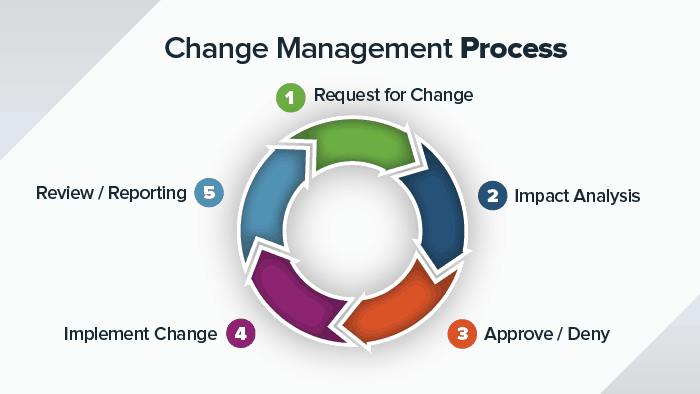Students Will Create a Change Management Plan
Question
 Students will create a change management plan that follows project management best practices to allow controlled changes to the project specifically for Schedule, Scope, Budget and Resources. The process should analyze the impact of changes to the project objectives and how changes to the overall project get approved or denied. Students may propose an alternative project of their own design that shows attainment of the corresponding course outcome. The mentor must approve the alternative project.
Students will create a change management plan that follows project management best practices to allow controlled changes to the project specifically for Schedule, Scope, Budget and Resources. The process should analyze the impact of changes to the project objectives and how changes to the overall project get approved or denied. Students may propose an alternative project of their own design that shows attainment of the corresponding course outcome. The mentor must approve the alternative project.
Model Answer to the Above Question
Introduction
A change management plan is an essential tool for the achievement of project success. This includes the roles and activities to manage and control change during different stages in the projects. Change is at most necessary during the execution and control stages of the project. Change is always defined against the project baseline which requires that a request for change is made and approved or denied by the relevant authorities. Change is very critical to success, and hence only responsible persons can authorize the change. For project success, there should be no change unless it’s evaluated and approved even in very critical conditions. Although the approval urgency can vary from one project to another, every changing aspect needs to be extensively evaluated. A change control board performs the role of approving or declining a change request. To promote consistency, a change request form is necessary, which helps captures all the essential elements of the change needed.
Thank you for visiting our site. Please remember you can always order a personalized, quality, and original answer just meant for you by following this link. Our able team is ready to help.
A project change request can be focused on the various aspects of the project. A change management plan identifies change on the project schedule, scope and budget, and resources. Change takes a critical element of project management, and it’s inevitable in the project. The change management plan focuses on proposing the aspects to consider before considering approving the change for any of the defined project aspect. The discussion also includes the impact that change has on the project objectives. Since any of the shareholders can request a change, the control teams need to assess its impact on the goal since change can as well be worthless or inconvenient. One consideration is that the shift in project control team includes project management leaders since the proposed project may lack the capacity to dispatch the proposed change successfully and effectively. In a construction, project change can occur at the execution and the control stages affecting the schedule, scope, budget, and resources and would thus need a well-defined control team for evaluation and approval.
Defined Plan for Change
There are two forms of changes that will be expected and upheld in the construction of the apartment and the perimeter wall. The customer will fund some changes while other changes will be based on the project team/ contractors. The design engineers can propose a change in the design especially on the interior design of segments of the building. This change will influence the disbursement of resources and causes changes in the budget. Changing the fittings to more durable type for safety and sustainability issues would mean adding more resources to the project. In this case, a change in the quality will be approved by the control team only if the proposed change influences the overall objective of the project. Customer proposed change will be based on the marketability value, and the influence of the customer has in the project. Some of the customers designed changes such as portioning of the individual stalls will be made at their costs after signing the tenancy contract. However, the team will consider if that change affects the durability of the apartment and if there would be a need to approve the change. The project team can be requested to independently fulfill the required change in the best interests of all stakeholders.
Schedule
This project is expected to run for 11 months to achieve all its objectives. Both structural and operational changes will affect the schedule to extend time assigned for some tasks at the expense of others. There is a need to maintain the project baseline to ensure a reflection of the current status of the project. The change request needs not to cause a significant overlap of tasks in the project plan. According to Harrison, and Lock, (2017) a four stages process can be useful in controlling the changes that would be approved for the schedule. The control team needs to determine the current status of the schedule. The project manager needs then need to influence the factors that could cause the schedule to change. There is a need for evaluation of the change to determine whether it’s a positive or negative change. Assessment of whether the changes have occurred and managing those changes as they occur would be very critical to the change management process. In the evaluation of the change factors analysis of the need for corrective action is necessary. For instance, construction is scheduled for nine months, and changes in the design would extend the assigned time. There is a need for an evaluation to ensure the change is valuable to the project.
Thank you for visiting our site. Please remember you can always order a personalized, quality, and original answer just meant for you by following this link. Our able team is ready to help.
Scope
The WBS for this project has four levels and will need to be sustained and controlled despite the requests for change. The level of change that the control team needs to evaluate and approve need to satisfy various aspects and objectives defined in the WBS. Effective control of the scope of the project is one essential requirement of project management (Bpayne, & Waytte, n.d.). There are some events if they occur the control team will approve the change to the scope. If there is change on the sponsor’s financial health and they do request for suspension of some tasks such considerations will have to be approved. Other change requests on the scope of the project will be declined especially if they result from increases in the overall costs. A change management system will be defined one which will ensure that the appropriate level of management authorizes the changes in the scope. The changes to the scope that results from decreasing in the cost will be assessed to ensure that the quality of the house will not be compromised.
Budget and Resources
All the change requests affect results from a need to increase or decrease the budget or reduce the resources including human resources. This change management plan is flexible to increasing or decreasing the budget by less than 2% but only under specialized approval. The resource allocation is considered to have been made in the best interests of the objectives and hence reducing or increasing the workforce will be avoided. However, in case of a risk team members will be requested to work for extra hours. To control the change in the budget and resources, all the evaluation process will be made by the project manager.
Impact of Changes to the Project Objectives
A poorly managed change control would lead to negative influence in the project objectives. Some of the goals like having classic apartments appealing to the market could be compromised. To the worse, the house may never be completed following insufficient funds. The impact change can have on the project objective determined, is useful in assessing the effectiveness of the quality managers. The schedule variance and cost variance are the primary aspects of change that will be used to determine the impact of change (Millhollan, 2008). The impact of change on the objectives is different for the various changes. Those changes that are inclined directly to the project scope are more sensitive and may demand closer attention. One approach to controlling change is to ensure an extensive understanding of the objectives of the project. At times the impact of change on the objectives is positive. In as much as the project manager would be committed to fulfilling the results as communicated the client could be unhappy with the results. Change is significant, and when there is an improvement in the quality of the product without escalation of the costs, the change will be adequately achieved.
How Changes to the Overall Project Get Approved or Denied
Approving and denying the change request will be completed by the project change control team. The project management isn’t in a capacity to approve all change requests. The project management will outline a standard form for making the change request. Any member of the project can make a change request; however, only the change control team will make the final decisions. Once a change request has been made, they will be evaluated to the aspect of the project that they affect such as the scope, schedule, budget or the resources. There is a need to have a clear score factor for the evaluation of the change request to ensure uniformity throughout the project period (Jalagat, 2016). A change process affects various operations, and hence the management will assess the impact against the objectives of the project. Sometimes consultations will be made before any decisions can be made and once approved there is needed to determine how to implement that change.
Conclusion
The discussion is a change management plan focusing on ensuring that the change process is completed within the scope of the needs of the stakeholders. As much as a project manager would fulfill all deliverables as requested by the client, it’s not a guarantee that they will be happy. This means then that change needs to be considered and controlled depending on the prevailing circumstances of the project. Change impacts the objectives either negatively or positively, and those assessments need to be evaluated before approval or denial decisions. To some extents, project managers success depends on their quality of controlling the change.
References
Bpayne, & Waytte, A. (n.d.). Framework for Project Management. Retrieved from https://opentextbc.ca/projectmanagement/chapter/chapter-4-framework-for-project-management-project-management/
Harrison, F., & Lock, D. (2017). Advanced project management: a structured approach. Routledge.
Jalagat, R. (2016). The Impact of Change and Change Management in Achieving Corporate Goals and Objectives: Organizational Perspective. International Journal of Science and Research (IJSR), 5, 1233-1239.
Kerzner, H., & Kerzner, H. R. (2017). Project management: a systems approach to planning, scheduling, and controlling. John Wiley & Sons.
Millhollan, C. (2008). Scope change control: control your projects or your projects will control you! Paper presented at PMI® Global Congress 2008—North America, Denver, CO. Newtown Square, PA: Project Management Institute.

 Borderline Personality Disorder is a condition that affects mood instability and makes it difficult for people to form relationships. According to Brüne (2016), unstable relationships, fear of being abandoned, inability to regulate emotions, feelings of depression, and high-risk behaviors are some of the characteristics of the condition. According to APA (2013), people with the disorder have increased chances of committing suicide. Brüne (2016) says that people suffering from the condition have paranoid ideas, and they always have self-injurious behavior. There are several intervention measures that are being used to manage borderline personality disorder. These intervention measures are generalized to all populations, but they can be adapted to work in specific circumstances such as in sexual minorities.
Borderline Personality Disorder is a condition that affects mood instability and makes it difficult for people to form relationships. According to Brüne (2016), unstable relationships, fear of being abandoned, inability to regulate emotions, feelings of depression, and high-risk behaviors are some of the characteristics of the condition. According to APA (2013), people with the disorder have increased chances of committing suicide. Brüne (2016) says that people suffering from the condition have paranoid ideas, and they always have self-injurious behavior. There are several intervention measures that are being used to manage borderline personality disorder. These intervention measures are generalized to all populations, but they can be adapted to work in specific circumstances such as in sexual minorities. Business Strategy
Business Strategy
 Cancer Awareness
Cancer Awareness During human development, several milestones occur from childhood to adulthood. The milestones are marked by the cognitive, physical, and social, emotional growth processes, which are essential stages in an individual’s life. Various theorists such as Piaget and Erik Erickson came up with theories to describe the human developmental processes. By focusing on the biography of
During human development, several milestones occur from childhood to adulthood. The milestones are marked by the cognitive, physical, and social, emotional growth processes, which are essential stages in an individual’s life. Various theorists such as Piaget and Erik Erickson came up with theories to describe the human developmental processes. By focusing on the biography of